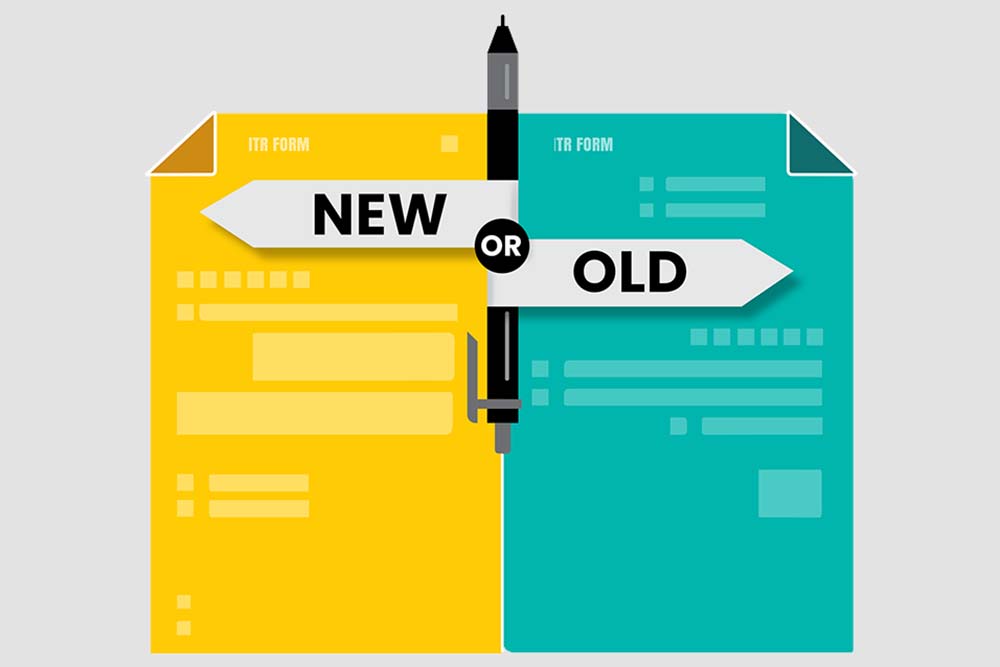The government made the new tax regime the default one from FY2023-24. However, you can still choose between the old and the new tax regime while filing your income tax return. But that would depend on your income slab and the deductions you wish to claim. We help you choose the most suitable tax regime in these five common scenarios
The new tax regime became the default one from financial year 2023-24. So, most likely, if you didn’t assess which tax regime is better for you, you would be on the new tax regime automatically. The good news is you can still opt for the tax regime that is the most beneficial for you before you file your income tax return (ITR) for FY24.
The new tax regime offers concessional tax rates, but doesn’t allow individuals to claim deductions under Section 80C, 80D and others, except standard deduction of Rs 50,000. But it also offers a tax rebate of Rs 7 lakh, making income up to that level tax-free. The old tax regime continues to reduce taxable income using deductions and exemptions.
If you haven’t already done so, this is the right time to choose your tax regime, as time is running short as you need to file your ITR by July 31, failing which you will have to pay a penalty on any pending tax. Do remember that while earlier, the income tax department typically used to extend the last date of filing returns, that didn’t happen last year.
We have chosen five common scenarios in which people end up asking the same question: should I go for the old tax regime or the new? We hope the analysis of these scenarios will answer the question.
Scenario 1: I maximise all my Section 80C deductions and have a home loan too. I also get a part of my salary as reimbursement.
There are two aspects that you will need to consider in this scenario to decide whether you should stay in the old regime.

One, you will need to assess the amount of deduction you can avail of and the income level you have. Says Mousami Nagarsenkar, partner, Deloitte Touche Tohmatsu India: “For instance, if your gross total income (without any deductions/exemptions) is more than Rs 15 lakh but less than Rs 50 lakh and if your deductions and exemptions—which you stand to lose if you opt for the new tax regime—are more than Rs 3.75 lakh, the old tax regime will be more beneficial in your case.” (see You Should Opt For Old Regime When...).
You can also use the calculator available on the income tax website (https://incometaxindia.gov.in/) to compare the tax liability under both regimes and then decide accordingly.
Two, you should consider the reimbursement allowed under the new tax regime. Says Nagarsenkar, “Some of the deductions available under the new tax regime are a standard deduction from salary income under Section 16(ia), a deduction for employer contribution to the National Pension System (NPS) under Section 80CCD(2) of the Act, and allowances notified under Section 10(14) like transport allowance granted to a handicapped employee to meet the expenditure to commute between the place of residence and place of work, conveyance allowance granted to meet the expenditure on conveyance for the performance of duties of an office, and so on.”
Scenario 2: I have a home loan and I avail of deductions on the principal and interest components, but my income is Rs 7 lakh.
As you have mentioned, you may be claiming a deduction up to Rs 2 lakh under income from house property under Section 24B of the Act for interest paid on the self-occupied house property, and deduction under Section 80C for the principal repayment as well.
“After availing the above, the net taxable income shall be Rs 3.5 lakh. After availing rebate under Section 87A of the Act, there shall be no tax liability. In the new tax regime, income up to Rs 3 lakh is exempted and additionally, you will get a tax rebate of up to Rs 25,000 which is available to resident individuals whose total taxable income is up to Rs 7 lakh, which is the present case. Accordingly, under the new regime as well there will be no tax liability,” says Nagarsenkar.
At the same time, one shouldn’t forget to factor in any additional income sources, such as rent, interest from investments, freelance work, among others. Says Abhishek Soni, CEO, Tax2Win, an income tax portal: “Calculate the total amount earned from each source over the tax period. Include these amounts in the relevant sections of your tax return or financial statement. Ensure that all the income is accurately reported to avoid penalties or audits.”
Also, add these to your total income before calculating tax payable under the two regimes. If tax under both regimes works out to be nil, it might be better to opt for the new regime to avoid the hassle of maintaining documents and paperwork, says Nagarsenkar.

Scenario 3: I am a consultant with an income of Rs 15 lakh. What will be different for me?
The decision to opt for the tax regime will depend on the amount of exemptions and deductions you are availing. “If an individual is claiming deductions like Section 80C and Section 80D and the interest on a home loan under Section 24, it is recommended that taxes be calculated under both regimes to determine which is more beneficial,” says Rahul Singh, senior manager, Taxmann, tax and corporate advisor.
But freelancers or consultants need to first decide whether they are opting for the presumptive tax scheme (PTS) or not. “The Income-tax Act, 1961 provides PTS for professionals under Section 44ADA. It applies to a resident individual or partnership firm (other than LLP) engaged in a specified profession. The specified profession includes 11 professions,” says Singh. Some of them are legal, medical, engineering, architectural, and technical consultancy.
Under PTS, 50 per cent of the profession’s gross receipts is deemed as the presumptive income of the taxpayer. This means that 50 per cent of the income is not subject to tax. For instance, if you are earning Rs 10 lakh, only Rs 5 lakh will be considered as taxable income.
“However, this scheme can be opted only if the gross receipts from the profession do not exceed Rs 50 lakh. The limit of Rs 50 lakh shall be increased to Rs 75 lakh if the aggregate amount of cash received during the previous year does not exceed 5 per cent of the total gross receipts during such year,” says Singh.
If you opt for PTS, you shall also be exempted from maintaining books of account and getting them audited as required under Section 44AB. Further, you can pay the entire advance tax due in a single instalment on or before March 15.
“Thus, if your profession is covered in the list of the notified professions, you can declare 50 per cent of your total receipts as presumptive income,” says Singh.

Scenario 4: I am a super senior citizen aged 85 years, and I have a pension income of Rs 15 lakh with medical expenditure of around Rs 1 lakh per annum on my spouse.
While the decision to opt for the tax regime will depend on the amount of exemptions and deductions available to the assessee, you should know that the quantum of deductions for super senior citizens is higher than what is available for younger individuals. Here are some examples.
Section 80D: This deduction is available in respect of health insurance premium. In the case of super senior citizens, the maximum deduction is Rs 50,000 for premiums paid (non-cash) for self, spouse, and dependent children, double of what is available to individuals under 60 years of age. You also get a deduction up to Rs 5,000 for preventive health check-ups for self, spouse, dependent children, or parents.
Deduction up to Rs 50,000 is also available for medical expenses for self, spouse, dependent children, and parents (paid non-cash) if the person is a senior citizen and has no medical insurance.
Section 80DDB: This deduction is available for the medical treatment of specified diseases. Says Singh: “A senior citizen can claim deduction under this Section if they incur expenditure on the medical treatment of a prescribed disease or ailment (as specified in Rule 11DD) for himself or any dependent, including spouse, children, parents, brother and sister of a senior citizen.”
The maximum amount of deduction is Rs 1 lakh or the actual amount incurred, whichever is lower.
Section 80TTB: A senior citizen can also claim a deduction of up to Rs 50,000 for interest earned from any deposits (including fixed deposits) from a banking company, cooperative society engaged in the banking business, or post office, says Singh.
Since senior citizens get some extra deductions compared to those up to the age of 60, one should ideally assess one’s taxable income. Typically, since the expenses, barring health, go down in one’s senior years, the income may not be taxable under the new regime.
Scenario 5: I am a retired individual with a rental income of around Rs 10 lakh from multiple properties.
It is important to note that while the deductions mentioned in the earlier scenarios are available under the old tax regime, individuals, including senior and super senior citizens, can also claim additional deduction—apart from the standard deduction—on rental income from house property under both the tax regimes.
If you want to opt for the old tax regime, you can claim a rebate under Section 87A when your total income is below Rs 5 lakh. To reach Rs 5 lakh, you should invest Rs 2 lakh in various options under chapter VIA, such as NPS, equity-linked savings scheme (ELSS), Public Provident Fund (PPF), and so on. The break-even point of the deduction is Rs 2 lakh (see You Should Opt Old Regime When...).
Besides this, municipal taxes levied by the local authority in respect of the house property are allowed to be deducted if such taxes are paid during the year. This deduction is available under both the new and the old regimes for all individuals.
Says Singh: “While computing income from house property, the standard deduction is allowed at the rate of 30 per cent, irrespective of the amount of expenditure incurred on maintenance or other specified things. This deduction is available under both the new and old regimes.”
Once you have taken these deductions into consideration, compare your saving versus the tax payable under the two tax regimes and decide accordingly.
meghna@outlookindia.com







